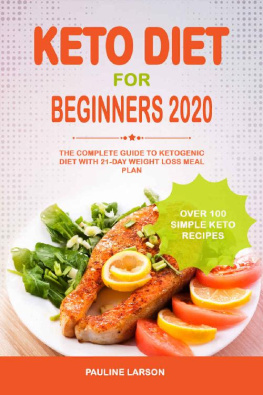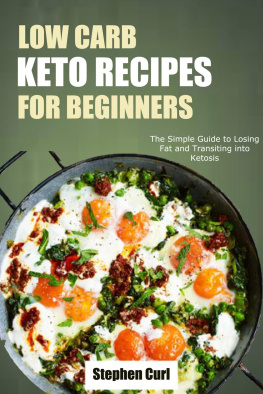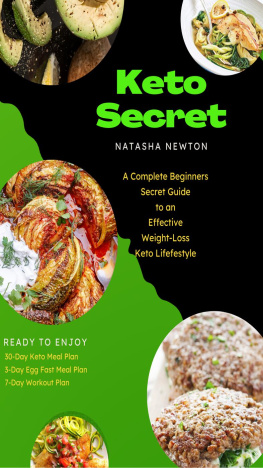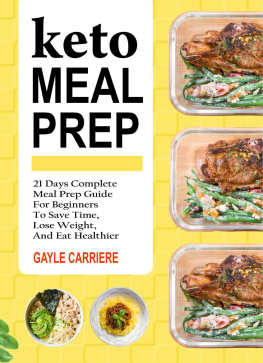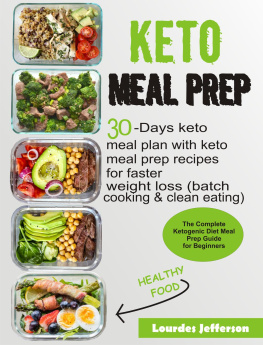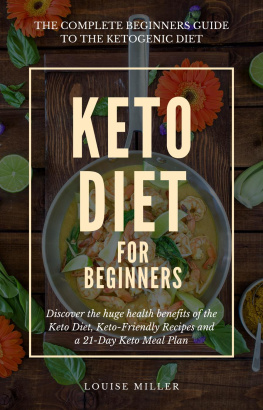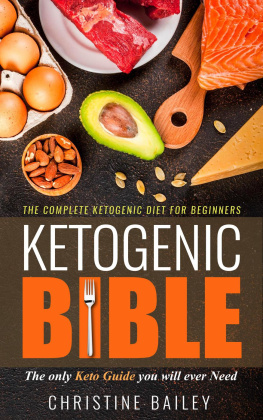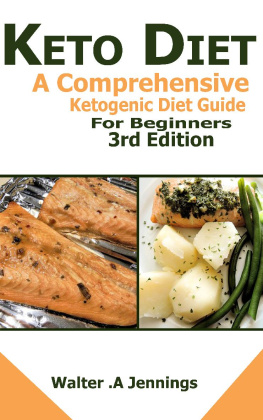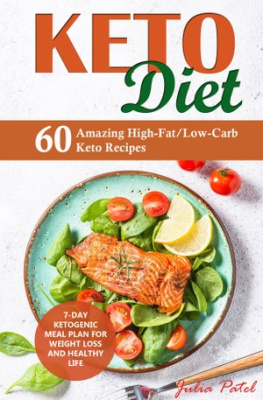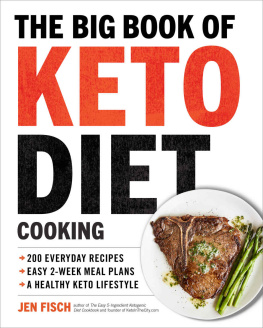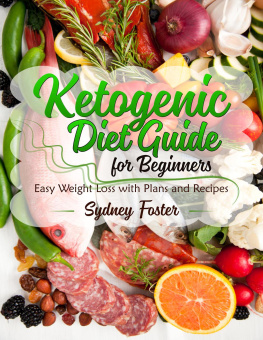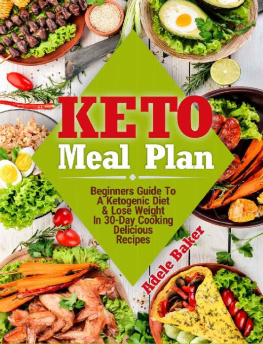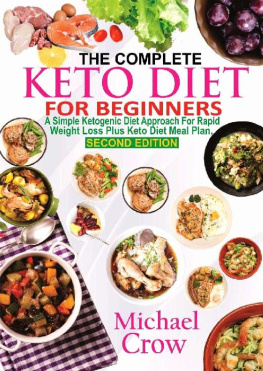Keto Diet for Beginners 2020
The Complete Guide to Ketogenic Diet with 21-Day Weight Loss Meal Plan and Over 100 Simple Keto Recipes
PAULINE LARSON
Copyright 2019 Pauline Larson
All rights reserved.
No part of this publication may be reproduced, distributed, or transmitted in any form or by any means, including photocopying, recording, or other electronic or mechanical methods, except as permitted by U.S. copyright law.
Legal Notice:
This book is copyright protected. This book is only for personal use. You cannot amend, distribute, sell, use, quote or paraphrase any part, or the content within this book, without the consent of the author or publisher.
Disclaimer Notice:
Please note the information contained within this document is for educational and entertainment purposes only. All effort has been executed to present accurate, up to date, and reliable, complete information. No warranties of any kind are declared or implied. Readers acknowledge that the author is not engaging in the rendering of legal, financial, medical or professional advice. The content within this book has been derived from various sources. Please consult a licensed professional before attempting any techniques outlined in this book.
Although the author and publisher have made every effort to ensure that the information in this book was correct at press time, the author and publisher do not assume and hereby disclaim any liability to any party for any loss, damage, or disruption caused by errors or omissions, whether such errors or omissions result from negligence, accident, or any other cause.
Table of Contents
Introduction
Not every diet is suitable for everyone as every person is different, both physically and genetically and have different lifestyle and taste preference. However, keto can work wonders for individuals who have weight and obesity problems, which is a major reason for serious health conditions.
The keto diet has seen a surge in its fame in past years. Everyone is talking about it, and the keto diet is now known as miracle diet. Celebrities, professional athletes, and dieticians, publicly touting keto diet benefits; its effects and incredible benefits, especially fast weight loss, are enough to prove that the keto diet really works!
The Ketogenic diet is not something new. It has been around us for nearly a century and has been treating epilepsy condition in people who dont respond well to anti-epileptic drugs. Back in the 1920s, researchers found that a high-fat and low-carb diet significantly reduce epileptic seizures. Then with time, its popularity grew, and now, everyone is a fan.
Heres everything you need to know about the keto diet, how its work, and why its a perfect solution for your weight loss problem.
What is Keto and How Does It Work?
Keto or ketogenic diet is a very low carb, moderate protein, and high-fat diet. The main difference between the Keto diet and other healthy diet is that it changes the way your body converts certain food into energy. Generally, the body relies on carb (sugar) reserves as a fuel, but keto diet focuses on drastic reduction carbohydrates and replaces these carbs with fats. When this happens, the body enters into a state called ketosis, which is the ultimate goal of a Keto diet. Ketosis is a metabolic process in which the body starts using stored fats when carbs and sugar reserves are insufficient. Ketosis converts stored fats in the liver into ketone, small molecules, which are then supplied as a source of energy for the brain.
In short, the ketogenic diet switches the fuel supply to fats that are burned in the body 24 x 7 hours. As a result, this composition of the Keto diet significantly reduce insulin and blood sugar level. And, when fats start to burns and ketones are produced, it enables your body to tap into its greater energy reserves and burn excess fats, leading to weight loss and improved mood as well. Other benefits can be derived from this diet with reference to different health conditions such as:
- Heart diseases
- Cancer
- Alzheimer disease
- Epilepsy
- Parkinson diseases
- Diabetes (type 2)
- Inflammation
- Brain injuries
- Acne
There are several versions of the Keto diet, but a standard ketogenic diet contains:
Fats: 75 to 90 %
Proteins: 20 to 25 %
Carbs: 5 to 10 %
The Science Behind Keto
Okay, so we know that a ketogenic diet is characterized by low-carb, medium-protein, and high-fat intake. The combination of these three ingredients will cause the body to go into ketosis. Ketosis is a metabolic shift in the body in a way that allows the body to burn fat rather than carbohydrates.
The carbohydrates that are consumed are converted into glucose and insulin. Here, glucose is basically sugar. Glucose is the most convenient source of energy because your body can convert it to energy easier. As such, the body prefers using that up first. Another byproduct of carbohydrates is insulin, which is a hormone produced by your pancreas. This hormone helps process glucose in your body by transporting the glucose in the body to where it is needed. When your body has enough energy, the excess glucose will be converted to adipose tissue, or fat, as a backup. Of course, that does not mean that the body uses that fat first if there are carbohydrates available.
You see, the fat in your body is considered to be the backup source of power. Therefore, in a normal situation, your body would burn carbohydrates, then fats, then proteins, in that order. As such, the body does not burn fat as effectively. Ketosis promotes weight loss by making the body prioritize burning fat, thus resulting in more fat being burned.
Many ordinary diets contain plenty of carbohydrates, which are not bad in itself. It is only bad when you take in more energy than you spend it, which means you create an energy leftover which would be converted to fat. Day by day, your weight adds up very quickly. For such a diet, glucose is the main source of energy because it contains plenty of it. However, the glucose in your body can only last you a few days. Your body will convert glucose to fat if you do not use glucose up. So when your glucose store runs dry in a few days, your body will switch to another source of energy through a biochemical process known as ketogenesis.
When this process starts, your liver starts to take the fat in your body and break it down, creating an alternative source of energy. When that happens, your ketone level goes up and your body. This is the moment when you enter ketosis.
How to Enter Ketosis
You have a few options when it comes to entering ketosis.
The most direct one is by depriving your body of carbohydrates, therefore glucose, through fasting for a long period of time. When you stop eating altogether, your body will turn to burn fat as a source of energy because it has no glucose to work with. But of course, fasting and intermittent fasting is a whole different subject on its own and we will not cover that in this book. But do remember that fasting has its caveat.
Another option is to eat less. You just have to consume less than 20 to 50 grams of your daily carbohydrate intake a day. This will depend on who is fasting. Some require fewer while some require more, perhaps even more than 50 grams. However, the bottom line is that people who are on a keto diet only consume 5% of their usual carbohydrate intake.
But whatever method you use, it all boils down to this:
- Cut down on carbs intake to 5% of regular intake
- Increase fat intake to 80%
- The lack of carbs will force the body to burn fat instead
- When the ketone level in your blood rises high enough, you enter a state of ketosis

